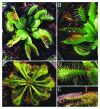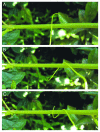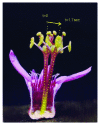Plants on the move: towards common mechanisms governing mechanically-induced plant movements
- PMID: 22231201
- PMCID: PMC3337191
- DOI: 10.4161/psb.6.12.18192
Plants on the move: towards common mechanisms governing mechanically-induced plant movements
Abstract
One may think that plants seem relatively immobile. Nevertheless, plants not only produce movement but these movements can be quite rapid such as the closing traps of carnivorous plants, the folding up of leaflets in some Leguminosae species and the movement of floral organs in order to increase cross pollination. We focus this review on thigmotropic and thigmonastic movements, both in vegetative and reproductive parts of higher plants. Ultrastructural studies revealed that most thigmotropic and thigmonastic movements are caused by differentially changing cell turgor within a given tissue. Auxin has emerged as a key molecule that modulates proton extrusion and thus causing changes in cell turgor by enhancing the activity of H(+)ATPase in cell membranes. Finding conserved molecules and/or operational molecular modules among diverse types of movements would help us to find universal mechanisms controlling movements in plants and thus improve our understanding about the evolution of such phenomena.
© 2011 Landes Bioscience
Figures





References
-
- Darwin C. The power of movement in plants. New York: D. Appleton and Company, 1880.
-
- de Langre E. Effects of wind on plants. Annu Rev Fluid Mech. 2008;40:141–68. doi: 10.1146/annurev.fluid.40.111406.102135. - DOI
Publication types
MeSH terms
Substances
LinkOut - more resources
Full Text Sources
